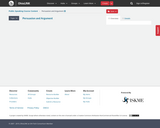
373 Results

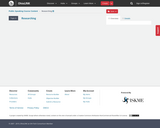
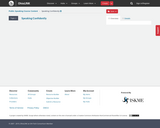
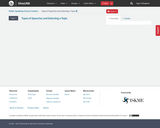

This half-semester course introduces and surveys the major public capital market real estate vehicles, REITs and MBS (with primary emphasis on CMBS). Some background is also included in basic modern portfolio theory and equilibrium asset pricing. This course is primarily designed to provide MSRED students with a basic introduction to the public capital market sources of financial capital for real estate, and how those markets value such capital investments.
- Subject:
- Business and Finance
- Economics
- Finance
- Social Science
- Material Type:
- Full Course
- Provider:
- M.I.T.
- Provider Set:
- M.I.T. OpenCourseWare
- Author:
- Geltner, David
- Date Added:
- 01/01/2007
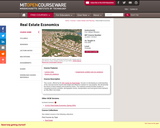
" This course, offered by the MIT Center for Real Estate, focuses on developing an understanding of the macroeconomic factors that shape and influence markets for real property. We will develop the theory of land markets and locational choice. The material covered includes studies of changing economic activities, demographic trends, transportation and local government behavior as they affect real estate."
- Subject:
- Business and Finance
- Economics
- Social Science
- Material Type:
- Full Course
- Provider:
- M.I.T.
- Provider Set:
- M.I.T. OpenCourseWare
- Author:
- Wheaton, William
- Date Added:
- 01/01/2008
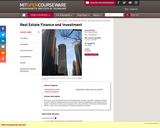
This course is an introduction to the most fundamental concepts, principles, analytical methods and tools useful for making investment and finance decisions regarding commercial real estate assets. As the first of a two-course sequence, this course will focus on the basic building blocks and the "micro" level, which pertains to individual properties and deals.
- Subject:
- Business and Finance
- Finance
- Material Type:
- Full Course
- Provider:
- M.I.T.
- Provider Set:
- M.I.T. OpenCourseWare
- Author:
- Geltner, David
- Date Added:
- 01/01/2006
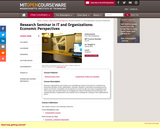
Builds upon relevant economic theories and methodologies to analyze the changes in organization and markets enabled by Information Technology, especially the Internet. Typical perspectives examined include industrial organization and competitive behavior, price theory, information economics, intangible asset valuation, consumer behavior, search and choice, auctions and mechanism design, transactions cost economics and incomplete contracts theory, and design of empirical studies. Extensive reading and discussion of research literature aimed at exploring the application of these theories to business issues and challenges raised by the Internet and related technologies. Business organizations and markets use a bewildering variety of structures to coordinate the productive activities of their stakeholders. Dramatic changes in information technology and the nature of economic competition are forcing firms to come up with new ways of organizing work. This course uses economic theory to investigate the roles of information and technology in the existing diversity of organizations and markets and in enabling the creating of new organizational forms.
- Subject:
- Business and Finance
- Management
- Material Type:
- Full Course
- Provider:
- M.I.T.
- Provider Set:
- M.I.T. OpenCourseWare
- Author:
- Brynjolfsson, Erik
- Date Added:
- 01/01/2004
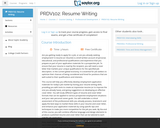
This course will help you effectively develop employment application materials for todayĺÎĺs job market by honing your resume writing skills, providing you with tools to create an impressive resume (or to improve the one you already have), and giving suggestions on developing an effective cover letter
- Subject:
- Business and Finance
- Material Type:
- Activity/Lab
- Full Course
- Homework/Assignment
- Reading
- Syllabus
- Provider:
- The Saylor Foundation
- Provider Set:
- Saylor Academy Professional Development
- Date Added:
- 10/24/2019
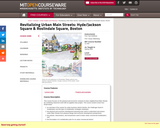
Workshop explores the integration of economic development and physical planning interventions to revitalize urban commercial districts. Covers: an overview of the causes of urban business district decline, revitalization challenges, and the strategies to address them; the planning tools used to understand and assess urban Main Streets from both physical design and economic development perspectives; and the policies, interventions, and investments used to foster urban commercial revitalization. Students apply the theories, tools and interventions discussed in class to preparing a formal neighborhood commercial revitalization plan for a client business district.
- Subject:
- Applied Science
- Architecture and Design
- Business and Finance
- Marketing
- Material Type:
- Full Course
- Provider:
- M.I.T.
- Provider Set:
- M.I.T. OpenCourseWare
- Author:
- Seidman, Karl
- Date Added:
- 01/01/2005

This book is intended for the Risk Management and Insurance course where Risk Management is emphasized.
When we think of large risks, we often think in terms of natural hazards such as hurricanes, earthquakes or tornadoes Perhaps man-made disasters come to mind such as the terrorist attacks in the U.S. on September 11, 2001. Typically we have overlooked financial crises, such as the credit crisis of 2008. However, these types of man-made disasters have the potential to devastate the global marketplace. Losses in multiple trillions of dollars and in much human suffering and insecurity are already being totaled, and the global financial markets are collapsing as never before seen.
Risk management will be a major focal point of business and societal decision–making in the 21st century. A separate focused field of study, it draws on core knowledge bases from law, engineering, finance, economics, medicine, psychology, accounting, mathematics, statistics and other fields to create a holistic decision-making framework that is sustainable and value- enhancing. This is the subject of this book.
- Subject:
- Business and Finance
- Finance
- Management
- Material Type:
- Textbook
- Provider:
- The Saylor Foundation
- Provider Set:
- Saylor Textbooks
- Author:
- Etti Baranoff
- Patrick Lee Brockett
- Yehuda Kahane
- Date Added:
- 01/01/2009
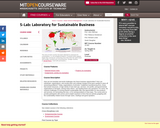
How can we translate real-world challenges into future business opportunities? How can individuals, organizations, and society learn and undergo change at the pace needed to stave off worsening problems? Today, organizations of all kinds--traditional manufacturing firms, those that extract resources, a huge variety of new start-ups, services, non-profits, and governmental organizations of all types, among many others--are tackling these very questions. For some, the massive challenges of moving towards sustainability offer real opportunities for new products and services, for reinventing old ones, or for solving problems in new ways. The course aims to provide participants with access and in-depth exposure to firms that are actively grappling with the sustainability-related issues through cases, readings and guest speakers.
- Subject:
- Business and Finance
- Life Science
- Manufacturing
- Nutrition
- Professional Studies
- Material Type:
- Full Course
- Provider:
- M.I.T.
- Provider Set:
- M.I.T. OpenCourseWare
- Author:
- Slaughter, Sarah
- Date Added:
- 01/01/2008
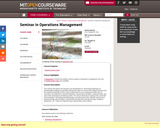
Topics vary from year to year. Typical examples from past years: manufacturing strategy, technology supply chains. This seminar will explore the purposes and development of Technology Roadmaps for systematically mapping out possible development paths for various technological domains and the industries that build on them. Data of importance for such roadmaps include rates of innovation, key bottlenecks, physical limitations, improvement trendlines, corporate intent, and value chain and industry evolutionary paths. The course will build on ongoing work on the MIT Communications Technology Roadmap project, but will explore other domains selected from Nanotechnology, Bio-informatics, Geno/Proteino/Celleomics, Neurotechnology, Imaging and Diagnostics, etc. Thesis and Special Project opportunities will be offered.
- Subject:
- Business and Finance
- Manufacturing
- Professional Studies
- Material Type:
- Full Course
- Provider:
- M.I.T.
- Provider Set:
- M.I.T. OpenCourseWare
- Author:
- Fine, Charles H.
- Date Added:
- 01/01/2002
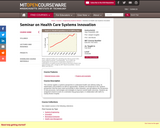
This seminar applies a systems perspective to understand health care delivery today, its stakeholders and problems as well as opportunities. Students are introduced to the 'systems perspective' that has been used successfully in other industries, and will address the introduction of new processes, technologies and strategies to improve overall health outcomes. Students are assigned to teams to work on a semester_long group project, in collaboration with staff of a nearby Boston hospital.
- Subject:
- Business and Finance
- Material Type:
- Full Course
- Provider:
- M.I.T.
- Provider Set:
- M.I.T. OpenCourseWare
- Author:
- Coughlin, Joseph
- Finkelstein, Stan
- Moses, Joel
- Date Added:
- 01/01/2010

This book is a practical discussion of actionable steps (six of them!) that students can take to land a job regardless of the market. Whether the estimate is 25% unemployment or single-digit unemployment, that number doesn’t apply to any one student. For any individual, the unemployment rate is 0% or 100%. One either has a job or doesn't. When any one person is looking for a job and there is 10% unemployment, that person just wants to be one of the nine people that has a job.
Students might think even that one job is beyond their grasp. They think they don’t have the right degree. Their school is in a different location than where they’d like to work. Not enough jobs are listed or employers are visiting the campus. This type of thinking cedes control of a student's search to outside forces. It is not up to professors, schools, career services support, or recruiters to get students a job. This book is about the proactive things that students can do to get themselves a job.
In the first chapter, Six Steps to Job Search Success covers the different types of job searches: full-time job after graduation, internship, return to workforce, career change, relocation. The rest of the book is about how, regardless of the type of job search or overall market, one can be proactive and successfully land a job. This textbook outlines a structured approach, actionable steps, and stresses the importance of a student's willingness to see this through.
Six Steps to Job Search Success provides that structure with six steps anyone can take to: 1. identify the types of jobs they’d like (Step 1: Identify Your Target) 2. position themselves for these jobs (Step 2: Create A Powerful Marketing Campaign) 3. figure out what employers are looking for (Step 3: Research) 4. develop relationships with prospective employers (Step 4: Network and Interview) 5. stay connected throughout the decision-making process and fix any problems that might arise (Step 5: Stay Motivated; Organized and Troubleshoot Your Search) 6. complete their search (Step 6: Negotiate and Close the Offer).
Connie and Caroline are both former recruiters with over 40 years of combined hiring experience between them. Connie led recruiting areas for three Fortune 500 companies, and Caroline led recruiting in-house for a Fortune 500 but also as an external recruiter for established firms and start-ups. They’ve hired thousands of people from interns to senior executives. They developed the process detailed in Six Steps to Job Search Success based on how hiring works.
The authors explain that in reality, the ability to look for a job and land a job is a separate and distinct skill than any of the skills required for the job itself. The goal of their book is share their job search techniques with your students so that your students can take control of their job search, add an exceptional new job to their career and enjoy the life rewards a satisfying career can bring. If you are interested in a practical approach that can deliver results, this book is for you and your course. Order a desk copy today and see for yourself.
- Subject:
- Business and Finance
- Material Type:
- Textbook
- Provider:
- The Saylor Foundation
- Provider Set:
- Saylor Textbooks
- Author:
- Carole Ceniza-Levine
- Connie Thanasoulis-Cerrachio
- Date Added:
- 01/01/2011
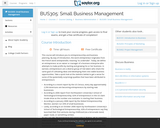
This course introduces Entrepreneurship and Business Planning. Upon successful completion of this course, students will be able to: analyze the entrepreneurial process through which business ideas are evaluated; identify the characteristics of successful entrepreneurs; demonstrate an awareness of strategies supporting entrepreneurship; distinguish between business ideas and opportunities; write a formalized business plan; write a marketing plan; examine their personal entrepreneurial potentials; know how to finance their business ventures; demonstrate an understanding of team-building dynamics. (Business Administration 305)
- Subject:
- Business and Finance
- Management
- Material Type:
- Assessment
- Full Course
- Homework/Assignment
- Lecture
- Lecture Notes
- Reading
- Syllabus
- Textbook
- Provider:
- The Saylor Foundation
- Date Added:
- 10/24/2019

Small Business Management in the 21st Century offers a unique perspective and set of capabilities for instructors. The authors designed this book with a “less can be more” approach, and by treating small business management as a practical human activity rather than as an abstract theoretical concept.
The text has a format and structure that will be familiar to you if you use other books on small business management. Yet it brings a fresh perspective by incorporating three distinctive and unique themes and an important new feature (Disaster Watch) which is embedded throughout the entire text. These themes assure that students see the material in an integrated context rather than a stream of separate and distinct topics.
First, the authors incorporate the use of technology and e-business as a way to gain competitive advantage over larger rivals. Technology is omnipresent in today’s business world. Small business must use it to its advantage. We provide practical discussions and examples of how a small business can use these technologies without having extensive expertise or expenditures.
Second, they explicitly acknowledge the constant need to examine how decisions affect cash flow by incorporating cash flow impact content in several chapters. As the life blood of all organizations, cash flow implications must be a factor in all business decision-making.
Third, they recognize the need to clearly identify sources of customer value and bring that understanding to every decision. Decisions that do not add to customer value should be seriously reconsidered.
Small Business Management in 21st Century boasts a new feature called Disaster Watch scenarios. Few texts cover, in any detail, some of the major hazards that small business managers face. Disaster Watch scenarios, included in most chapters, cover topics that include financing, bankers, creditors, employees, customers who don’t pay, economic downturns, and marketing mistakes.
- Subject:
- Business and Finance
- Finance
- Management
- Material Type:
- Textbook
- Provider:
- The Saylor Foundation
- Provider Set:
- Saylor Textbooks
- Author:
- David Cadden, Sandra Lueder
- Date Added:
- 05/22/2019

Social entrepreneurship, Corporate Social Responsibility (CSR)—there are many names for the work that businesses do that relates directly to a social or environmental issue and that reflects many of the goals in the United Nations Sustainable Development Goals (UN SDGs), not the least of which is Goal #8: Decent Work and Economic Growth. There are many forms that social entrepreneurship or corporate social responsibility take. What is undeniable is that businesses have become increasingly sensitive and involved with tying their business model and goal more directly to work that improves society or our planet. Your job in this assignment is to find an existing business and explore what it is doing—or what it could be doing—to improve life on earth, using the UN SDGs as a framework.
- Subject:
- Business and Finance
- Material Type:
- Assessment
- Homework/Assignment
- Author:
- Rebecca Razavi
- Date Added:
- 03/02/2021
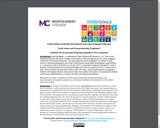
Open pedagogy - a component of Open Educational Resources - is a "free access" educational practice that places students at the center of their learning process in a more engaging, collaborative learning environment. The main objective of this assignment is to enhance social justice by reducing inequalities, one of the United Nations Sustainable Development Goals (SDGs), in a community in the United States or abroad. This is a renewable assignment designed to create a hands-on learning experience for students through which they can improve lives in a community of their choice and share the outcomes of their work with others. In this interdisciplinary assignment, students will integrate theories and practices from two academic disciplines, Communication Studies and Business Administration, to achieve the SDG #10, Reduced Inequalities.
- Subject:
- Business and Finance
- Communication
- Communications & Media
- Material Type:
- Activity/Lab
- Assessment
- Homework/Assignment
- Provider:
- Montgomery College Open Pedagogy
- Author:
- Ali Alavi
- Andree Betancourt
- Date Added:
- 10/24/2019
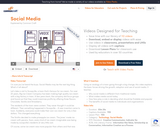
An introduction to Social Media via a story about a small town with many flavors of ice cream.
- Subject:
- Arts and Humanities
- Business and Finance
- Communications & Media
- English as a Second Language
- Material Type:
- Lecture
- Provider:
- Common Craft
- Author:
- Lee LeFever
- Sachi LeFever
- Date Added:
- 05/28/2008